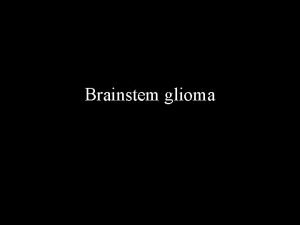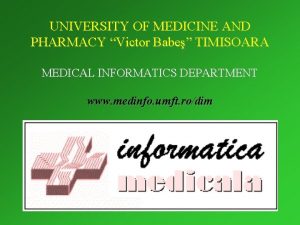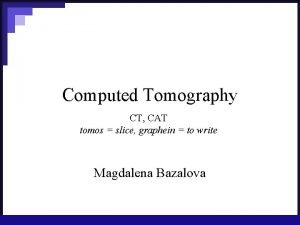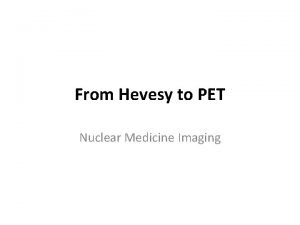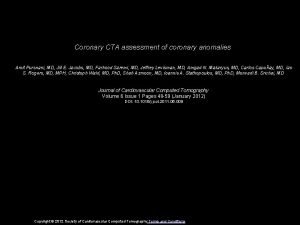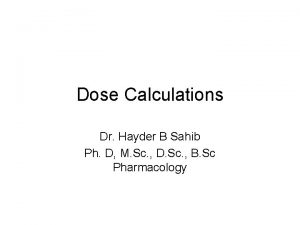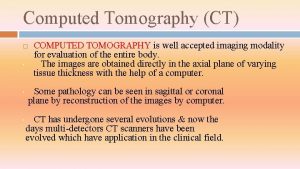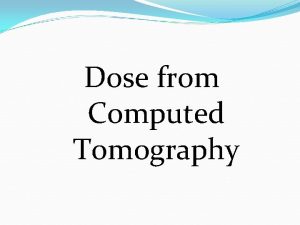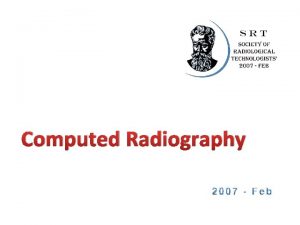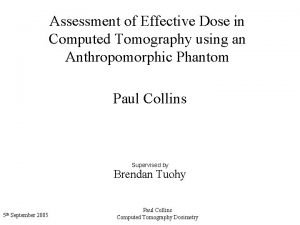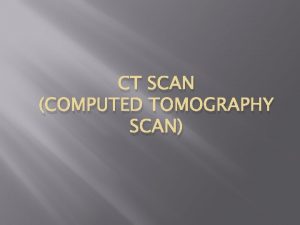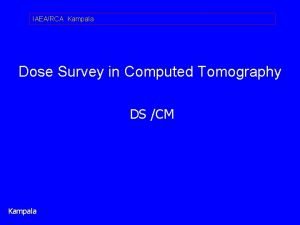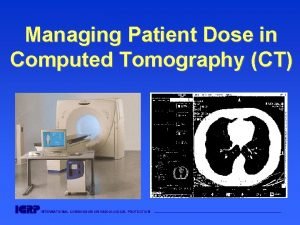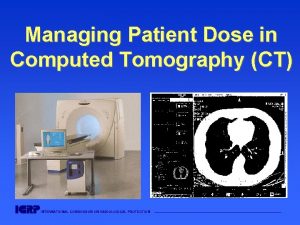Radiation dose assessment in Computed Tomography of pediatric










- Slides: 10

Radiation dose assessment in Computed Tomography of pediatric abdominopelvic at Namazi Hospital in 2017 Fariba Zarei 1, 2, Fariba Tadrisinik 2, Rezvan Ravanfar Haghighi 1, * 1 Medical Imaging Research Center, Shiraz University of Medical Sciences, Shiraz, Iran 2 Radiology Department, Shiraz University of Medical Sciences, Shiraz, Iran

Introduction • CT scan is one of the most important non-invasive diagnostic tools in modern healthcare. • Current epidemiological outcomes proposed an increase of cancer risk after receiving CT scans in childhood or adolescence. • The number of pediatric abdominal CT cases has increased considerably in our institute in recent years. • The aim of this study is to evaluate the CT dose indices including CTDIvol, DLP and effective dose in pediatric abdomen and pelvic CT scan at Namazi Hospital affiliated to Shiraz University of Medical Sciences.

Materials and Methods • The 417 numbers of population in this cross-sectional/ retrospective study included all pediatric patients, 0 to 15 years old, who were referred to Namazi Hospital to preform abdomen and/or pelvic CT scan during 2017. • It has to be noted that the patients were divided into four age groups: 0 -1, 1 -5, 5 -10 and 10 -15 years. • Two CT scanners, including 16 -slice MDCT Brilliance from Philips and 16 -slice MDCT Bright-Speed from GE company were used to scan pediatric patients. • The CT dose indices information of the patient were extracted from PACS system. • CTDIvol and DLP for each patient was recorded in excel-sheet from the page of dose report which is available at the end of CT image file.

Materials and Methods • Since the radiation dose in CT is dependent on the patient size, we measured and evaluated the Size Specific Dose Estimate (SSDE). • • SSDE was estimated on the basis of the American Association of Physicists in Medicine (AAPM) report No. 204. 1 • Effective diameter of each case was calculated by measuring AP and Lateral dimensions of patient using an axial slice of abdomen/pelvic CT image. • Conversion factor was determined on the basis of the patient’s effective diameter from AAPM report No. 204 and used to estimate SSDE.

Results • The results of this study shows that the highest indication of abdomen and pelvic CT requests is for abdominal pain (Fig. 1). • It can be seen in Fig. (2) that the CTDIvol are comparable in both GE and Philips CT systems, although the higher number of cases in lower age groups, 0 -10 years, were scanned by GE system. FIG. 1 FIG. 2

Results • Evaluation of SSDE vs CTDI volume in GE and Philips CT system for 0 to 5 years old is shown in Fig. (3). • This figure shows that SSDE is two times higher than the corresponding CTDIvol for all pediatric patients (0 -10 years) who were scanned by abdomen and pelvic protocol by GE and Philips CT systems.

Results • The results of CTDIvol, DLP measurements in abdomen and pelvic pediatric CT scanning according to the age range (0 -1, 1 -5, 5 -10 and 10 -15 years) for the data gathered from both GE and Philips CT systems are given below. Age group year CTDIvol (m. Gy) DLP (m. Gy. cm) Mean(min-max) 25% 75% 90% 0 -1 8(2 -20) 6 8 16 433(109 -1548) 253 479 563 1 -5 6(2 -12) 4 7 8 331(54 -775) 216 402 551 5 -10 6(3 -21) 5 6 8 436(152 -1213) 298 517 691 10 -15 8(4 -21) 5 8 11 634(184 -1870) 398 786 1182

Discussion • In this study, mean and 75% of CTDIvol in 0 to 1 years pediatric patient (for abdomen and pelvic CT) was lower than that CTDI reported by researchers in Iran University 2, while it was higher than the result of the study in South Korea 3 and Australia 4. • The CTDIvol found in the present study, for 0 -1 year age group, was comparable to that reported by Turkish researchers 5, while the SSDE resulted in present study was more than that of Turkish group’s. • The result of this study showed that CTDIvol result in 1 -5 years age group, with GE and Philips systems were less than that in Iran University and South Korea, but it is more than the that reported from Australia. • The SSDE and CTDIvol, for 1 -5 years pediatric patient in abdomen and pelvic CT, were more than that in the Turkish study.

Conclusion • The results of the present research can be considered as a reference for future studies in pediatric abdominopelvic CT in Namazi hospital. • The results of SSDE measurements reveal that in pediatric patients the size of the patient is an important factor in CT dose estimation. • Proper CT protocol with suitable Phantom should be selected for dose optimization.

References 1 -Boone JM, Strauss KJ, Cody DD, et al. Size-Specific Dose-Estimate (SSDE) in pediatric and adult body CT examination. Report of AAPM task group 204. published by: American Association of Physicists in Medicine, One Ellipse, College Park, MD 20740 -3846. 2 - Afzalipour R, Abdollahi H, Hajializadeh MS, Jafari S, Mahdavi SR. Estimation of diagnostic reference levels for children computed tomography: A study in Tehran, Iran. International Journal of Radiation Research. 2019 Jul 1; 17(3): 407 -13. 3 - Hwang JY, Do KH, Yang DH, Cho YA, Yoon HK, Lee JS, Koo HJ. A survey of pediatric CT protocols and radiation doses in South Korean hospitals to optimize the radiation dose for pediatric CT scanning. Medicine. 2015 Dec; 94(50). 4 - Bibbo G, Brown S, Linke R. Diagnostic reference levels of paediatric computed tomography examinations performed at a dedicated Australian paediatric hospital. Journal of medical imaging and radiation oncology. 2016 Aug; 60(4): 475 -84. 5 - Özsoykal İ, Yurt A, Akgüngör K. Size-specific dose estimates in chest, abdomen, and pelvis CT examinations of pediatric patients. Diagnostic and Interventional Radiology. 2018 Jul; 24(4): 243.
